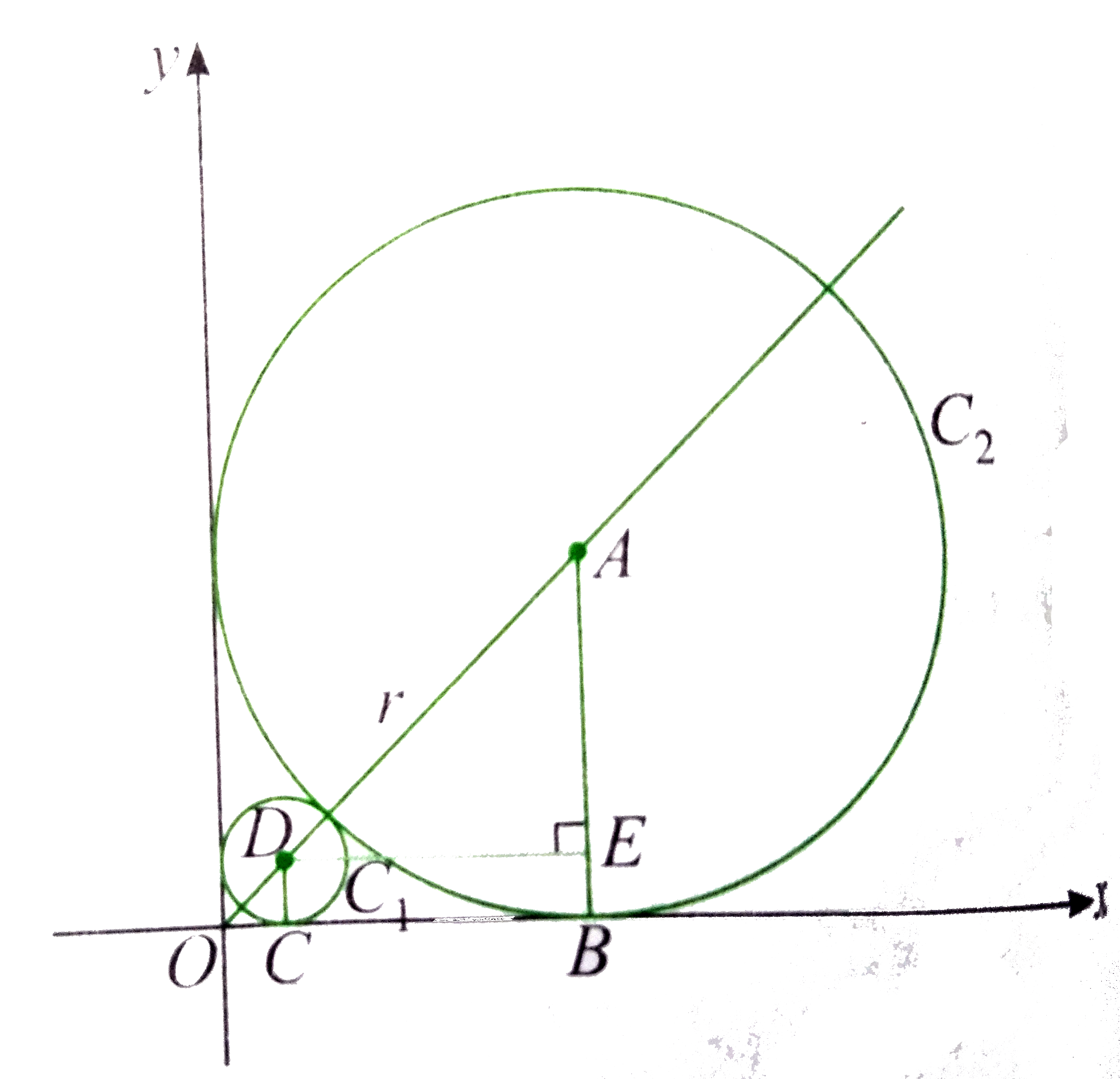A circle C1, of radius 2 touches both x-axis and y- axis. Another circle C1 whose radius is greater than 2 touches circle and both the axes. Then the radius of circle is (a) 6−4√2 (b) 6+4√2 (c) 3+2√3 (d) 6+√3Solution in Bengali
The correct Answer is:2
Let the two circles be as shown in the figure.
The smaller circle is x2+y2=1.
Clearly, from the figure
cos45∘=DEAD
⇒1√2=r−1r+1
⇒r+1=√2r−√2
⇒r=√2+1√2−1=3+2√2

Topper's Solved these Questions
- BOOK - CENGAGE PUBLICATIONCHAPTER - CIRCLE EXERCISE - Multiple Correct Anser Type29videos
CIRCLE
- BOOK - CENGAGE PUBLICATIONCHAPTER - CIRCLE EXERCISE - Linked Comprehension Type (For Problem 1-3)3videos
CIRCLE
- BOOK - CENGAGE PUBLICATIONCHAPTER - CIRCLE EXERCISE - CONCEPT APPLICATION EXERCISE 4.172videos
CIRCLE
- BOOK - CENGAGE PUBLICATIONCHAPTER - BINOMIAL THEOREMEXERCISE - Comprehension11videos
BINOMIAL THEOREM
- BOOK - CENGAGE PUBLICATIONCHAPTER - CIRCLESEXERCISE - Comprehension Type8videos
CIRCLES
Similar Questions
about to only mathematics
03:01View SolutionEach side of a square is of length 6 units and the centre of the square Is ( - 1, 2). One of its diagonals is parallel to x+y=0. Find the co-ordinates of the vertices of the square.
02:56View SolutionThree concentric circles of which the biggest is x2+y2=1, have their radii in A.P If the line y=x+1 cuts all the circles in real and distinct points. The interval in which the common difference of the A.P will lie is:
05:18View SolutionConsider a G.P. with first term (1+x)n, |x|<1, common ratio 1+x2 and number of terms (n+1). Let 'S' be sum of all the terms of the G.P., then
The coefficient of xn is 'S' isView Solution
In the diagram as shown, a circle is drawn with centre C(1,1) and radius 1 and a line L. The line L is tangent to the circle at Q. Further L meets the y-axis at R and the x-axis at P in such a way that the angle OPQ equals θ where 0<θ<π2.
Coordinate of Q is04:06View SolutionC1 is a circle of radius 1 touching the x- and the y-axis. C2 is another circle of radius greater than 1 and touching the axes as well as the circle C1 . Then the radius of C2 is 3−2√2 (b) 3+2√2 3+2√3 (d) none of these
04:54View SolutionEquation of a circle of radius 2 and touching the circles x2+y2−4|x|=0 is x2+y2+2√3y+2=0 x2+y2+4√3y+8=0 x2+y2−4√3y+8=0 none of these
04:24View SolutionA circle C_(1), of radius 2 touches both x -axis and y -axis.Another circle C_(1) whose radius is greater than 2 touches circle and both the axes.Then the radius of circle is
04:27View SolutionThe equation of the circle whose radius is 3 and touches internally with another circle x2+y2−2x+4y−6=0 at (−2,2) is
03:12View SolutionFour circles each with radius 2 touch both the axes then the radius of the largest circle touching all the four circles is
04:17View SolutionFour circles each with radius 2 touch both axes then the radius of the largest circle touching all the four circles is
04:17View SolutionC1 is a circle of radius 1 and touching both the axis . C2 is another circle which touch both the axis and also circle C1 whose radius >1 then radius of C2 is
06:27View SolutionC1 is a circle of radius 1 touching the x- and the y-axis. C2 is another circle of radius greater than 1 and touching the axes as well as the circle C1 . Then the radius of C2 is (a)3−2√2 (b) 3+2√2 3+2√3 (d) none of these
03:00View SolutionA circle C1, of radius 2 touches both x-axis and y- axis. Another circle C1 whose radius is greater than 2 touches circle and both the axes. Then the radius of circle is (a) 6−4√2 (b) 6+4√2 (c) 3+2√3 (d) 6+√3
01:15:50View Solutionत्रिज्या 2 का एक वृत्त C1 x-अक्ष और y-अक्ष दोनों को स्पर्श करता है। दूसरा वृत्त C2 जिसकी त्रिज्या 2 से अधिक है, वृत्त C1 व दोनों अक्षों को स्पर्श करता है। वृत्त C2 की त्रिज्या होगी
02:26View Solutionत्रिज्या 2 का एक वृत्त C1 x-अक्ष और y-अक्ष दोनों को स्पर्श करता है। दूसरा वृत्त C2 जिसकी त्रिज्या 2 से अधिक है, वृत्त C1 व दोनों अक्षों को स्पर्श करता है। वृत्त C2 की त्रिज्या होगी
View Solution

